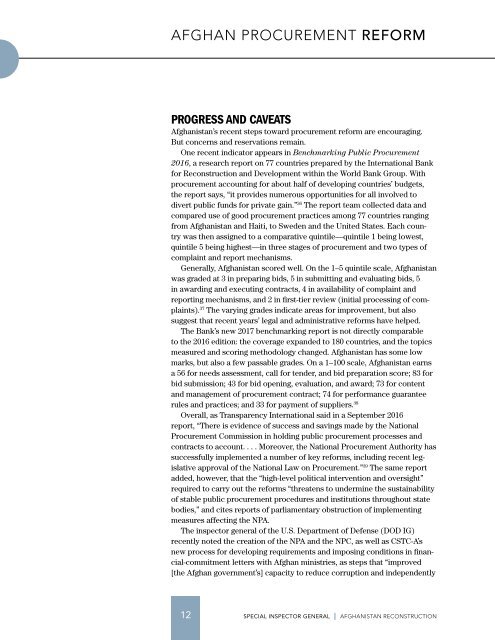SIGAR
2017-01-30qr
2017-01-30qr
Create successful ePaper yourself
Turn your PDF publications into a flip-book with our unique Google optimized e-Paper software.
AFGHAN PROCUREMENT REFORM<br />
PROGRESS AND CAVEATS<br />
Afghanistan’s recent steps toward procurement reform are encouraging.<br />
But concerns and reservations remain.<br />
One recent indicator appears in Benchmarking Public Procurement<br />
2016, a research report on 77 countries prepared by the International Bank<br />
for Reconstruction and Development within the World Bank Group. With<br />
procurement accounting for about half of developing countries’ budgets,<br />
the report says, “it provides numerous opportunities for all involved to<br />
divert public funds for private gain.” 36 The report team collected data and<br />
compared use of good procurement practices among 77 countries ranging<br />
from Afghanistan and Haiti, to Sweden and the United States. Each country<br />
was then assigned to a comparative quintile—quintile 1 being lowest,<br />
quintile 5 being highest—in three stages of procurement and two types of<br />
complaint and report mechanisms.<br />
Generally, Afghanistan scored well. On the 1–5 quintile scale, Afghanistan<br />
was graded at 3 in preparing bids, 5 in submitting and evaluating bids, 5<br />
in awarding and executing contracts, 4 in availability of complaint and<br />
reporting mechanisms, and 2 in first-tier review (initial processing of complaints).<br />
37 The varying grades indicate areas for improvement, but also<br />
suggest that recent years’ legal and administrative reforms have helped.<br />
The Bank’s new 2017 benchmarking report is not directly comparable<br />
to the 2016 edition: the coverage expanded to 180 countries, and the topics<br />
measured and scoring methodology changed. Afghanistan has some low<br />
marks, but also a few passable grades. On a 1–100 scale, Afghanistan earns<br />
a 56 for needs assessment, call for tender, and bid preparation score; 83 for<br />
bid submission; 43 for bid opening, evaluation, and award; 73 for content<br />
and management of procurement contract; 74 for performance guarantee<br />
rules and practices; and 33 for payment of suppliers. 38<br />
Overall, as Transparency International said in a September 2016<br />
report, “There is evidence of success and savings made by the National<br />
Procurement Commission in holding public procurement processes and<br />
contracts to account. . . . Moreover, the National Procurement Authority has<br />
successfully implemented a number of key reforms, including recent legislative<br />
approval of the National Law on Procurement.” 39 The same report<br />
added, however, that the “high-level political intervention and oversight”<br />
required to carry out the reforms “threatens to undermine the sustainability<br />
of stable public procurement procedures and institutions throughout state<br />
bodies,” and cites reports of parliamentary obstruction of implementing<br />
measures affecting the NPA.<br />
The inspector general of the U.S. Department of Defense (DOD IG)<br />
recently noted the creation of the NPA and the NPC, as well as CSTC-A’s<br />
new process for developing requirements and imposing conditions in financial-commitment<br />
letters with Afghan ministries, as steps that “improved<br />
[the Afghan government’s] capacity to reduce corruption and independently<br />
12<br />
SPECIAL INSPECTOR GENERAL I AFGHANISTAN RECONSTRUCTION







